Why Has Ford Issued So Many Recalls in 2024?
Ford is no stranger to recalls, but 2024 has been a record-setting year—even by their standards. With 93 recalls already on the books and the 100th looming, it’s fair to wonder: what’s driving this surge? The answer is a mix of increased regulatory scrutiny, more complex vehicle tech, and Ford’s own push to get ahead of potential safety issues before they spiral.
According to the National Highway Traffic Safety Administration (NHTSA), automakers across the board are facing more recalls as vehicles become rolling computers. Ford, in particular, has been aggressive about identifying and addressing even minor compliance gaps. While that’s a headache for owners, it’s also a sign the company is prioritizing safety and transparency—two things that matter when you’re behind the wheel.
What’s the Issue With the 2025 F-150 Hybrid Seatbelt Chime?
Let’s get specific. One of the latest recalls affects over 56,000 2025 F-150 Hybrids. The problem? The seatbelt warning chime might not sound when you start the truck if you’re not buckled up. Sounds minor, but it’s a big deal in terms of federal crash safety standards.
Here’s how it played out: In May, a Ford employee noticed the missing chime. Digging deeper, engineers discovered that if the 12-volt battery is running low, the audio head unit can reset, which sometimes silences the warning chime. No chime means drivers might forget to buckle up, and that’s a risk regulators won’t tolerate.
The fix is a software update for the audio control module, ensuring the chime sounds every time—no matter the battery’s mood. Ford plans to notify owners by mail in late August, with a second letter once the remedy is ready. Until then, F-150 Hybrid drivers should double-check those seatbelts, just in case.
Are Bronco Owners Affected by These Recalls Too?
Yes, but it’s a much smaller group. Only 59 Bronco Upfit kits—sold as dealer accessories or through Ford Performance—are involved. These kits, which cost upwards of $5,200, add a 2-inch lift, fender flares, matte black accents, and a beefier spare tire carrier.
Here’s where things went sideways: The upgraded spare tire carrier isn’t compatible with Broncos that only have a rearview camera (as opposed to the full 360-degree camera system). This mismatch can cause the rearview camera to go blank, which is a no-go for safe reversing. Ford received three reports before pulling the trigger on a recall.
Dealers will inspect affected Broncos and replace the rearview camera if needed. If you’ve got one of these tricked-out Broncos, it’s worth checking with your dealer—even if you haven’t noticed an issue yet.
How Do These Recalls Compare to Industry Trends?
Ford’s recall numbers are high, but they’re not alone. According to a 2023 report from the NHTSA, the industry as a whole saw over 1,000 recalls last year, affecting more than 30 million vehicles. As automakers pack more tech into their cars and trucks, the risk of software glitches and compatibility issues rises. In fact, software-related recalls have nearly doubled in the last five years.
What’s different about Ford is their willingness to act fast—even on relatively minor issues. That’s partly due to lessons learned from high-profile safety incidents in the past, and partly a reflection of today’s regulatory environment. The bottom line: more recalls now can mean fewer accidents and lawsuits down the road.
What Should Ford Owners Do If They’re Affected?
If you own a 2025 F-150 Hybrid or a Bronco with an accessory spare tire carrier, keep an eye on your mailbox. Ford will send official recall notices with instructions on how to get your vehicle fixed—free of charge. In the meantime, you can check your vehicle’s recall status using the NHTSA’s online tool or by calling your local Ford dealer.
Don’t ignore these notices. Even if the issue seems minor, recalls are about keeping you and your passengers safe. And if you’re ever unsure, a quick call to your dealer can clear things up—no harm, no foul.
What’s the Real Impact for Ford Drivers and the Brand?
For drivers, the immediate impact is a little inconvenience—maybe a trip to the dealer, maybe a wait for a software update. But the upside is peace of mind. Ford’s proactive approach means you’re less likely to face a serious safety issue down the line.
For Ford, the recall wave is a double-edged sword. On one hand, it’s a PR headache and a logistical challenge. On the other, it shows the company is serious about safety and compliance. In a market where trust is everything, that’s a smart play—even if it means some short-term pain.
The big takeaway? Vehicle safety isn’t about perfection—it’s about smarter adjustments. Start with one change this week, and you’ll likely spot the difference by month’s end.

